Eco-Friendly Green Flooring Products
Green Flooring | Green Maintenance
Options are now available to choose from a rapidly growing line of carpets and other flooring made from natural, recycled, and eco-friendly materials. Durable, stylish, and often less expensive than conventional floors and carpets, these sustainable options provide a responsible and healthy way to enhance your home.
Going Green
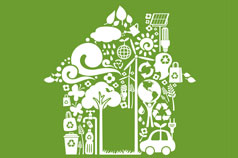
Today, manufacturers, architects, designers and builders are stepping up to address their role in providing materials, designs and practices that pave the way for environmentally responsible homes.
You have a role too. Whether you are remodeling or building new, choosing Green materials for your home will benefit your health, comfort, environment and finances.
In this section, we are going to cover what it really means to be green, tips on how you can be more green, hot new products that make it easy to be green and remain stylish at the same time.
Green Flooring
Green flooring is any flooring that is sustainable, eco-friendly, contains recycled content, is recyclable, leaves a small carbon footprint or has low VOC's (Volatile Organic Compound). There are different degrees of green when referring to different types of flooring.
Cork
Better than a renewable resource because it is a harvested resource (only the bark is harvested from the tree)
A recycled product because cork floors are made from the waste cork that makes wine stoppers.
A law in the 1930's called “The 9 Year Law” was passed to keep cork from being harvested any sooner than every 9 years. The tree has to reach 60 cm in circumference before it can be harvested. The first harvest from a cork tree can only occur at age 25.
The tree is not destroyed or damaged when harvesting cork.
To complete the environmentally sound process, water based finishes and adhesives should be used.
Bamboo
Bamboo is a rapidly renewing resource that matures in three years
It regenerates without need for replanting
It also requires minimal fertilization or pesticides
There currently is no FSC certified bamboo so it is important to see what you can confirm about the bamboo you are interested in before purchasing.
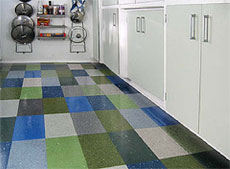
Carpet
According to the Carpet and Rug Institute: The carpet industry is minimizing carpet's impact on the environment through the new “3 Rs” which stand for reduce, reuse and recycle. When carpet reaches the end of its long life, it is reused to make new carpet or is recycled into a variety of products, ranging from roofing shingles and railroad ties to automotive parts.
Factors that determine if carpet is “green”: carpet fibers, toxics content, dye, VOC emissions, and recycled content.
The Green Label and Green Label Plus from the Carpet and Rug Institute ensure that customers are purchasing among the lowest emitting carpet, adhesive and cushion products on the market.
Stone
There is no clear data on the impact of using stone as a building material on the environment; when the data is collected it will contain information on water and energy consumption, yields from raw materials, recyclability and other measures that are considered in life cycle assessments, energy used in transportation, processing and selling the material.
Stone does have the following features:
- It's a natural product
- It has an enduring life cycle so it doesn't have to be replaced
- Ease of care and maintenance
- Recyclable
- Quarry and manufacturing use best practices
- Can be reclaimed
Hardwood
- Natural Resource
- Renewable
- Recyclable
- Suitable for a “healthy home” environment
- Forests are managed for replanting
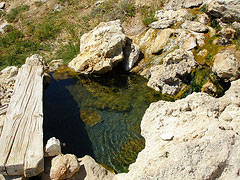
Linoleum
- Made from all natural materials
- The natural raw materials used to create Linoleum are available in abundance: linseed oil, rosin, wood flour, cork flour, ecologically responsible pigments and jute.
- These raw materials are harvested or extracted with relatively little energy consumption. The main energy resource for the process is the sun. The plants and trees that supply linoleum's raw materials also contribute to the production of oxygen and the subsequent reduction of carbon dioxide in the atmosphere, thus reducing the amount of greenhouse gasses present in the atmosphere.
- Can be recycled
- The energy obtained from incinerating linoleum is roughly equivalent to or even more than that which is used in production.
- Linoleum can be safely added to landfill refuse sites, where natural decomposition takes place. Linoleum is fully biodegradable and does not release harmful substances or gases such as chlorine and dioxins.
- Adhesives are 100% solvent free and meet all low VOC requirements
- Does not require maintenance from harmful chemicals
- Linoleum contains virtually no trace of toxic material and is naturally beneficial to air quality.
Ceramic Tile
- Rarely release emissions
- Some contain recycled content
- Long lasting and not replaced frequently
- Requires little maintenance
- Value is unclear due to it's weight causing more fuel during transportation
Carpet Cushion
- The Carpet and Rug Institute (CRI) has established the Green Label program to test for VOCs in cushion used under carpet. This program helps you choose low-emission cushion. You can identify these products by looking for the program's green and white seal. These products are continuously monitored to ensure that they maintain compliance.
- Cushion products are characterized as prime polyurethane, bonded polyurethane, mechanically frothed polyurethane, rubber-hair, rubber-jute, synthetic fiber, resinated or coated synthetic fiber, rubber and rubberized polyurethane.
- Cushions are tested for total volatile organic compounds (TVOCs), butylated hydroxytoluene (BHT), formaldehyde and 4-phenylcyclohexine (4-PCH).
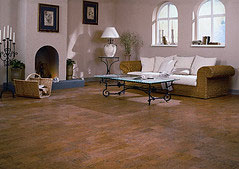
Carpet cushion can be:
- Made from 100% recycled bonded cushion from polyurethane foam or 100% recycled content in Rebond Carpet Cushion, a bonded polyurethane product
- Made with 97% recycled rubber for carpet underlayment
- Made with no CFC's, latex or chemical additives
- Made with 100% recycled tire rubber carpet pad. Withstands temperatures from 40 to 120 degrees. Free of toxic materials such as PCB, mercury, and formaldehyde
- Made from ground tire scrap rubber granules bonded with latex and 92% recycled tire rubber.
Installation
- Use adhesives with low VOC's
- Choose water based finishes over solvent based
- Acceptable adhesives are listed here: www.greenhomeguide.com
- Adhesives
- Adhesives are just as important to consider when purchasing flooring as the flooring itself. Adhesives with harmful toxins can damage indoor air quality by giving off
- harmful gasses.
Tips for Adhesives:
- Choose low VOC's (Volatile Organic Compounds)
- Do not contain formaldehyde
- Qualify for the Carpet and Rug Institutes Indoor Air Quality green label
- Once installed, floors still give off gas compounds
- Less durable floors have to be replaced more often
- High maintenance floors use more harsh chemicals
- Consider floors that don't have to be refinished
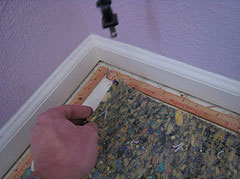
Green Maintenance
In addition to types of green flooring, there are products that can be used in conjunction with flooring that may possess green qualities. The most common are adhesives and cleaners. There are further considerations than just the actual flooring that will be purchased. The installation method and products used should be taken into consideration as well as how the final product will be maintained.
We make it easy to set up your families free personalized in-home Green flooring design appointment. Call us at 703-771-3383.
Cleaners
Tips for Cleaners:
- Choose products with natural ingredients
- Consider homemade cleaners like vinegar, baking soda or mild dishwashing detergent
- Read labels thoroughly for ingredients.
Maintaining your green living space:
- Keep caulked areas caulked. Every degree of temperature variance in a home can result in up to 10% addition to your heating and cooling expenses.Check your doors.
- Energy can be lost through doors that are not spaced properly from the floor. If you are having flooring replaced or added, a professional installer can check your doors for proper install height.
- Minimize use of space heaters. Spaces heaters are energy hogs and can generate more than 2 pounds of greenhouse gas per hour. These heaters don't help your hardwood floors because the heaters increase the contraction of hardwood floors.
Purchase hardwood floors with the FSC Seal that are not clear cut or harvested in a sustainable fashion. There are only 4% of our own native, old growth forests still standing. The US is the worlds largest importer and consumer of timber woods and products.










